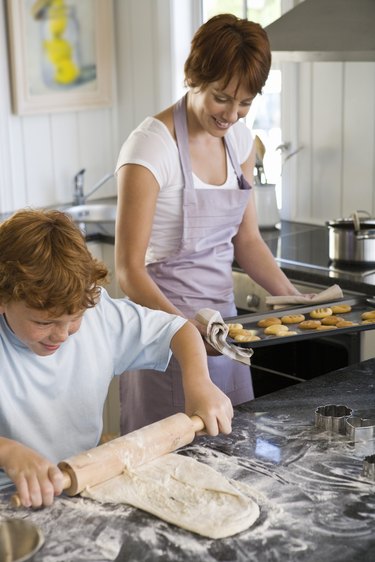
When you pull a pan of hot cookies out of the oven, the last thing you want is for your delectable treats to stick to the cookie sheet. To prevent this, you must treat your pan properly before laying out your cookie dough. Each type of cookie recipe has its own directions as to how the cookie sheet should be prepared for baking. Some recipes, such as chocolate chip cookies, do particularly well on a greased and floured cookie sheet. While cake flour and all-purpose flour are not interchangeable in the recipe itself, you can use cake flour to flour the pan before baking the cookies.
What is Cake Flour?
Video of the Day
Cake flour is different from all-purpose flour, in several ways. It is made only of soft wheat, unlike all-purpose flour, which is made of both hard and soft wheat. The real distinction between the two is that cake flour has less protein, resulting in a lighter, tenderer cookie, and is more finely milled than all-purpose flour. Some cookie recipes require cake flour, while others do not. While the type of flour can make a difference in the taste and texture of your cookies, it will work just fine when dusting your cookie sheet.
Video of the Day
Read the Recipe
Before you start, read your recipe closely for directions that are specific to the type of cookie you are making. While many people believe that you should grease, spray or flour a cookie sheet before you put anything put on it, some recipes do not require any prep to the pan. Cookies with a lot of butter or shortening fall into this category. If you prepare your pan incorrectly, your cookies may spread too much -- or not enough, altering the final product.
How to Flour the Pan
If your cookie recipe requires a greased and floured pan, you need only a few ingredients. Butter and vegetable shortening are ingredients that bakers frequently use for greasing cookie sheets. Avoid using oils because they can burn on the surface of the pan, allowing the cookies to burn, while leaving an unsightly coating in the pan. Use your hands, a paper towel or a pastry brush to spread the butter or shortening in a thin layer all over the cookie sheet. Next, sprinkle a tablespoon of cake flour over the surface of the pan. Tap the pan on each side so the flour evenly coats the entire pan. Discard any extra flour into the trash can.
Considerations
If you choose to use cake flour to dust your pan before baking, keep in mind that first you have to grease the pans so that the flour can adhere to the pan. You can use the flour alone for rolling out the dough to prevent it from sticking to the work surface, rolling pin or your hands without any grease, but for a non-stick surface on the pan, use butter or shortening first. Also, consider the type of cookies that you are making. The floured surface can cause more of a crust to form on the bottom of the cookie, and if too much flour is used, it can leave the bottom of the cookie a little white. Cake flour also contains gluten, although it does have less gluten than all-purpose flour.